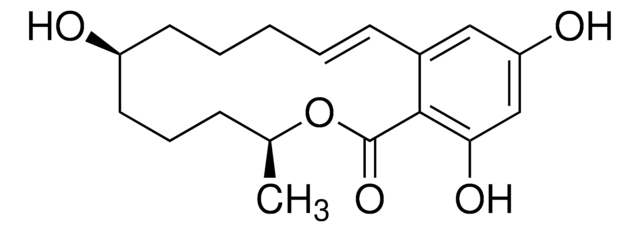CRM16869
Diquat metabolite Monopyridone
certified reference material, TraceCERT®, Manufactured by: Sigma-Aldrich Production GmbH, Switzerland
Sinonimo/i:
1-Oxo-9,10-dihydro-1H-10a-aza-8a-azoniaphenanthrene chloride, 6,7-Dihydro-9-oxo-9H-dipyrido[1,2-a:2′,1′-c]pyrazin-5-ium chloride
About This Item
Prodotti consigliati
Grado
certified reference material
TraceCERT®
Livello qualitativo
Nome Commerciale
TraceCERT®
Durata
limited shelf life, expiry date on the label
Produttore/marchio commerciale
Manufactured by: Sigma-Aldrich Production GmbH, Switzerland
Formato
neat
Temperatura di conservazione
2-8°C
Stringa SMILE
O=C1N2CC[N+]3=CC=CC=C3C2=CC=C1.[Cl-]
InChI
1S/C12H11N2O.ClH/c15-12-6-3-5-11-10-4-1-2-7-13(10)8-9-14(11)12;/h1-7H,8-9H2;1H/q+1;/p-1
FYUAZDQCXQJCPZ-UHFFFAOYSA-M
Cerchi prodotti simili? Visita Guida al confronto tra prodotti
Categorie correlate
Descrizione generale
Certified content by quantitative NMR incl. uncertainty and expiry date are given on the certificate.
Download your certificate at: http://www.sigma-aldrich.com
Diquat monopyridone is a common degradation product of Diquat. Diquat is a nonselective, defoliant, preharvest, and desiccant herbicide that belongs to the bipyridinium class. Diquat can rapidly penetrate through the leaf surface but is not taken up by the roots, due to its strong adsorption onto the soil particles. Its activity is based on the liberation of the superoxide anion radical, followed by hydrogen peroxide, causing tissue destruction by oxidative stress. The herbicidal activity of diquat is more pronounced in daylight, aerobic conditions, high humidity, and temperature.
Diquat is not approved for its use in the European Union. The maximum residue limit (MRL) for diquat presence in the crops varies between 0.05 mg/kg in most of the commodities to 10 mg/kg for linseed and barley.
The EU residue definitions are broader, however, the toxicological data is still missing for the diquat metabolites, monopyridone and dipyridone, to compare their toxicity with the parent compound.
Applicazioni
- Detection of two diquat metabolites in urine and serum of poisoned patients after ingestion of combined herbicides, paraquat and diquat
- Analysis of paraquat, diquat, and two diquat metabolites in biological materials by high-performance liquid chromatography coupled with UV and fluorescence detectors
Note legali
Avvertenze
Danger
Indicazioni di pericolo
Classi di pericolo
Acute Tox. 2 Inhalation - Acute Tox. 3 Dermal - Acute Tox. 3 Oral - Aquatic Acute 1 - Aquatic Chronic 1 - Eye Irrit. 2 - Skin Irrit. 2 - Skin Sens. 1 - STOT RE 1 Oral - STOT SE 3
Organi bersaglio
Respiratory system
Codice della classe di stoccaggio
6.1A - Combustible acute toxic Cat. 1 and 2 / very toxic hazardous materials
Classe di pericolosità dell'acqua (WGK)
WGK 2
Punto d’infiammabilità (°F)
Not applicable
Punto d’infiammabilità (°C)
Not applicable
Scegli una delle versioni più recenti:
Certificati d'analisi (COA)
It looks like we've run into a problem, but you can still download Certificates of Analysis from our Documenti section.
Se ti serve aiuto, non esitare a contattarci Servizio Clienti
Possiedi già questo prodotto?
I documenti relativi ai prodotti acquistati recentemente sono disponibili nell’Archivio dei documenti.
Il team dei nostri ricercatori vanta grande esperienza in tutte le aree della ricerca quali Life Science, scienza dei materiali, sintesi chimica, cromatografia, discipline analitiche, ecc..
Contatta l'Assistenza Tecnica.
![[Des-Tyr22]-Calcitonin salmon](/deepweb/assets/sigmaaldrich/product/images/282/634/15345f68-95be-4b5f-abc2-cb170099f26f/640/15345f68-95be-4b5f-abc2-cb170099f26f.jpg)





